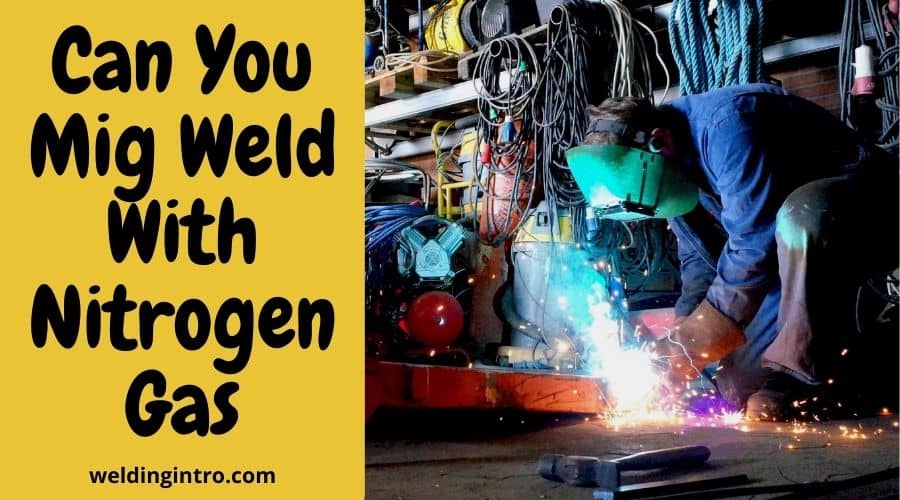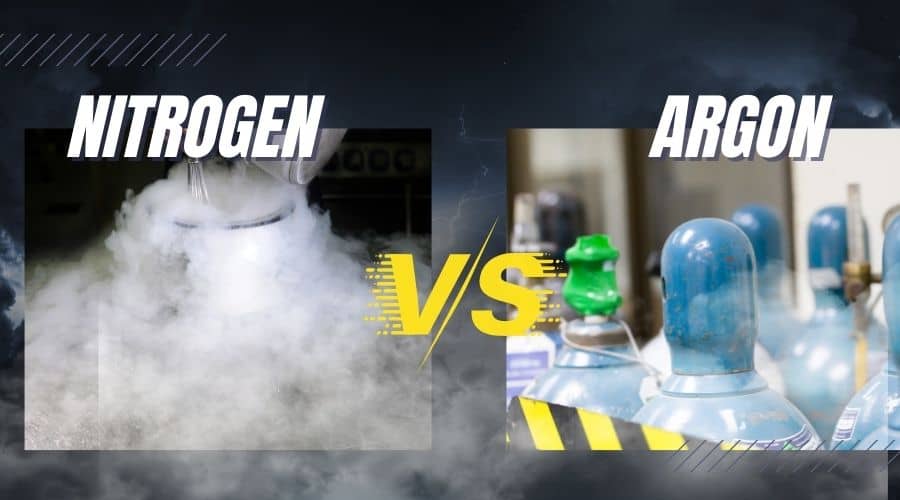MIG welding typically uses a wire rod that works as the electrode and is shielded by a gas flow or a mixture of gases. This welding process is compatible with using different types of gas for example oxygen, carbon dioxide, helium, argon etc.
What about nitrogen? Can you mig weld using nitrogen gas?
Lets find the answer-
Is it possible to MIG weld with Nitrogen?

As a semi-inert gas, it’s possible to use Nitrogen in different scenarios of MIG welding. However, the question remains to what degree you can use Nitrogen for MIG welding.
Nitrogen can bring excellent results in MIG welding if used as a purging gas or mixed with argon while shielding. But as Nitrogen is not fully inert like argon, you can’t totally replace it with other gases.
How does Nitrogen help in MIG welding
Now that we know Nitrogen can be used in MIG welding, let’s see how exactly it helps MIG welding-
- Better mechanical property: Whether used as purging or shielding gas, the presence of Nitrogen tends to increase the metal’s tensile strength. Especially, welding stainless steel can be greatly benefitted from the use of Nitrogen.
- Corrosion resistance: Nitrogen mixed with argon as shielding gas can increase the corrosion resistance of the metal. In the long run, you have more durable welding with a longer lifespan without any corrosion buildup.
- Stops oxidation: Oxidation is a common challenge in every welding project, and it just keeps increasing with temperature. But because of Nitrogen’s non-reactive nature, it plays an important role in controlling oxidation.
- Better arc stability: Arc stability is another crucial part of any welding project. With poor stability, the welding emits spatter, resulting in material loss, poor weld bead quality, and increased cleaning time. In this regard, Nitrogen can be a great help in providing better arc stability.
- Deep weld penetration: Deep penetration is another precondition of a good welding results. When mixed with other common shielding gases like argon or helium, Nitrogen ensures a better heat transfer and makes the penetration process easier. The mixer of nitrogen and argon is good for heavy metal welding like bridge construction or in construction projects.
Also Check
What are the applications of Nitrogen in MIG welding?
Now that you know that Nitrogen can be used in MIG welding and how it helps, let’s clear out the specific applications nitrogen offers in MIG welding.
- As a shielding gas: This is the most common and talked about the application of Nitrogen in MIG welding. You already know, in MIG and TIG welding, a shielding gas is used to protect the weld from oxidation. This job of shielding is done flawlessly by done by the mixture of argon and Nitrogen.
- As purging gas: Another common use of purging gas, but this time nitrogen can work on its own. Argon and Nitrogen both can be used as purging gas, and both are non-reactive gases. But the production cost is so much lower for Nitrogen, making it an excellent choice as purging gas in MIG welding.
- As pre-heating gas: Pre-heating is an important part of the welding process that comes with a few benefits. For example, it reduces the cooling rate of the welding to prevent cracking and prevents micro structure buildup. This pre-heating is another widely used application of Nitrogen.
Is there any problem using Nitrogen for mig weld?
Normally, there is absolutely no concern if you use the right amount of Nitrogen in MIG welding for different applications. Nitrogen can be used as a sole gas for purging, so there is no issue at all. However, the problems still remain when you use Nitrogen for shielding purposes.
Though Nitrogen is pretty non-reactive, it’s not as noble as argon gas, and there is a slight reactivity in Nitrogen. So if you fail to balance the amount of argon and Nitrogen in the shielding gas mixture, it can affect the quality of the weld in a bad way.
What about the safety issue
Safety issues will always be there in any kind of welding job, but there is no particular issue that can arise by the use of Nitrogen. Typically, MIG welding can cause electrical and radiation-related hazards. Additionally, welding fumes and inert gas can be another major concern if you don’t use proper safety gear.

As a completely inert gas heavier than air, inhaling it can cause immediate unconsciousness. To avoid these safety issues, there are several things you can do.
For example, checking out the equipment, using safety gears, and welding only by qualified personal can help avoid any unforeseeable safety hazard.
Nitrogen vs Argon: Which is the best purging gas for MIG welding?

In case you don’t know, purging is the method of eliminating oxygen, water vapor or any other welding gasses from the weld joint. Most of the metals we work with, whether stainless steel, carbon steel or different alloy, are pretty sensitive to these things.
Now, this elimination is done by using fully or a partly inert gas like argon and Nitrogen. As they are chemically non-reactive, they work great removing oxygen, vapor or any other gasses. Another benefit of these non-reactive gasses is that they can prevent any explosion and corrosion buildup.
Now that you know what purging is and what gasses are used, let’s see the differences between these gasses and determine which one is a better choice for MIG welding.
As we are talking specifically about purging, the preference actually comes down to economics and availability. As argon is a noble welding gas, completely non-reactive and inert, of course, it’s a better choice than using Nitrogen.
On the other hand, Nitrogen might not be labeled as a noble gas, but it’s also non-reactive like argon. So, in terms of usage, both gasses have similar characteristics and are really good choices for purging.
But the production cost makes all the difference here, and in this case, Nitrogen is a way better choice than argon. As Nitrogen’s main ingredient is raw air, it’s way cheaper to generate.
So, in terms of cost-friendliness, nitrogen is the better purging gas in MIG welding.
Can you TIG weld using nitrogen gas?
TIG welding is quite similar to MIG welding, which also works with an electrode and welding shielding gasses. Typically, TIG is used for delicate projects where precise welding is required. Now the question is “whether Nitrogen can be used for TIG welding”?
The answer is YES. You can use Nitrogen for TIG welding, only if you combine it with argon. And you can TIG weld duplex stainless steel with nitrogen. This is because duplex stainless steel is a combination of austenitic and ferritic stainless steel. When these two types of stainless steel are combined, it creates an extreme corrosion resistance and durability with a lower weight.
But to achieve the characteristics mentioned above, you have to make sure the weld doesn’t get exposed.
Here, Nitrogen comes with a strong hold to protect the weld and balance the elements of duplex stainless steel.
What kind of welding is nitrogen used for?
Nitrogen is commonly used as a shielding gas in certain welding processes and applications, primarily in plasma cutting and some metal spraying processes. Here’s a brief overview:
- Plasma Cutting: Nitrogen is often used as a plasma gas in plasma cutting. Plasma cutting is a process that uses a high-velocity jet of ionized gas (plasma) to cut through electrically conductive materials. Nitrogen is suitable for this purpose as it helps to create a clean and efficient cut, especially in non-ferrous metals like aluminum.
- Metal Spraying: In some metal spraying applications, nitrogen can be used as a carrier gas. Metal spraying, also known as thermal spraying, involves melting or heating a base material and propelling it onto a surface to create a coating. Nitrogen can be used as a non-reactive carrier gas to transport the molten metal particles to the substrate.
Can you weld aluminum with nitrogen?
Welding aluminum with nitrogen as a shielding gas is not a common practice. In traditional welding processes like TIG (Tungsten Inert Gas) or MIG (Metal Inert Gas) welding, argon shielding gas is the preferred for welding aluminum.
While nitrogen can be used as a plasma gas in certain cutting applications, it is not typically recommended as a shielding gas for aluminum welding. The high reactivity of nitrogen with molten aluminum and weld defects like the porosity damages the weld quality of welding.
If you are welding aluminum, it is advisable to use a shielding gas specifically designed for aluminum welding, such as pure argon or a mixture of argon and helium.
Frequently Asked Questions
1. Does nitrogen react with steel?
Nitrogen generally does not react with steel under normal atmospheric conditions. Nitrogen is an inert gas, meaning it is relatively unreactive and does not readily participate in chemical reactions with metals like steel.
2. Is nitrogen a shielding gas?
Nitrogen is not typically used as a shielding gas in conventional welding processes like TIG (Tungsten Inert Gas) or MIG (Metal Inert Gas) welding. In these processes, inert gasses such as argon and helium are commonly used as shielding gasses to protect the weld pool from atmospheric contamination.
Though nitrogen is not a standard shielding gas for most welding processes, it has specific applications where its properties are beneficial, such as in plasma cutting.
3. Can I use nitrogen instead of argon for welding?
Yes, nitrogen can be used as a shielding gas for certain welding processes, but it’s not as common as argon, especially for processes like TIG (Tungsten Inert Gas) welding. Argon is preferred in many welding applications because it provides better arc stability and is more effective at shielding the weld from atmospheric contamination.
Nitrogen is sometimes used in specific welding applications, such as plasma cutting and certain types of metal spraying. In these processes, nitrogen can be employed as a plasma gas or as part of a shielding gas mixture.
4. Is It Possible To Do Mig Welding Without Using Any Gas
The answer is yes, you can. You can weld heavy thick metals as well as thin pipe without gas. For that you will need a special type of welder and welding wire. The welder type is called flux core welder. And welding wire with flux is required to use for gas less welding. Flux prevents the atmospheric contamination of the weld pool while welding replaces the job of gas.
Last words
That’s a wrap for today. I hope my article was helpful enough to teach the ins and outs of using Nitrogen in MIG welding. As you can see throughout the article, Nitrogen can be a great and economical choice in different applications of MIG welding.
If you know how to balance out the optimal quantity in mixing, Nitrogen can really boost the corrosion resistance and overall metal integrity of the welding.
Related Article